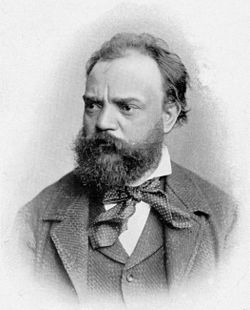Piano Trio No. 4 (Dvořák)
The Piano Trio No. 4 in E minor, Op. 90, B. 166, (also called the Dumky trio from the subtitle Dumky) is a composition by Antonín Dvořák for piano, violin and cello. It is among the composer's best-known works. It is also a well-known example of chamber music that significantly deviates from the traditional structure of classical chamber music, both in terms of the quantity of movements and the formal organization of those movements. TitleDumky, the plural form of dumka, is a Ukrainian term. Originally, it is the diminutive form of the term Duma, plural dumy, which refers to epic ballads, specifically a song or lament of captive people.[1] During the nineteenth century, composers from other Slavic countries began using the duma as a classical form to indicate a brooding, introspective composition with cheerful sections interspersed within. Dvořák used the dumka form in several other compositions, including his Dumka for Solo Piano, Op. 35; Slavonic Dance No. 2; String Sextet; and his Piano Quintet, Op. 81. HistoryDvořák completed the trio on 12 February 1891. It premiered in Prague on 11 April 1891, with violinist Ferdinand Lachner, cellist Hanuš Wihan, and Dvořák himself on piano.[1] The same evening, Prague's Charles University awarded the composer an honorary doctorate. The work was so well received that Dvořák performed it on his forty-concert farewell tour throughout Moravia and Bohemia, just before he left for the United States to head the National Conservatory of Music of America in New York City. The trio was published while Dvořák was in America and was proofread by his friend Johannes Brahms.[2] StructureThe piece is in six sections:
The composition features six dumky episodes throughout. The initial three dumky are connected together without interruption in the harmonically complementary keys given above, in effect forming a long first movement. The final three dumky are presented in unrelated keys, thus giving the overall impression of a four-movement structure.[3] Music critic Daniel Felsenfeld describes the form as follows:
Musicologists Derek Katz and Michael Beckerman observe, "Whereas in the quintet [Op. 81] he had borrowed a plan from Schumann to mold his dumka into a quasi-traditional framework, here he allows each of the six dumky to stand fully realized on its own."[5] Discography
References
External links
|
||||||||||||||||||||||||














